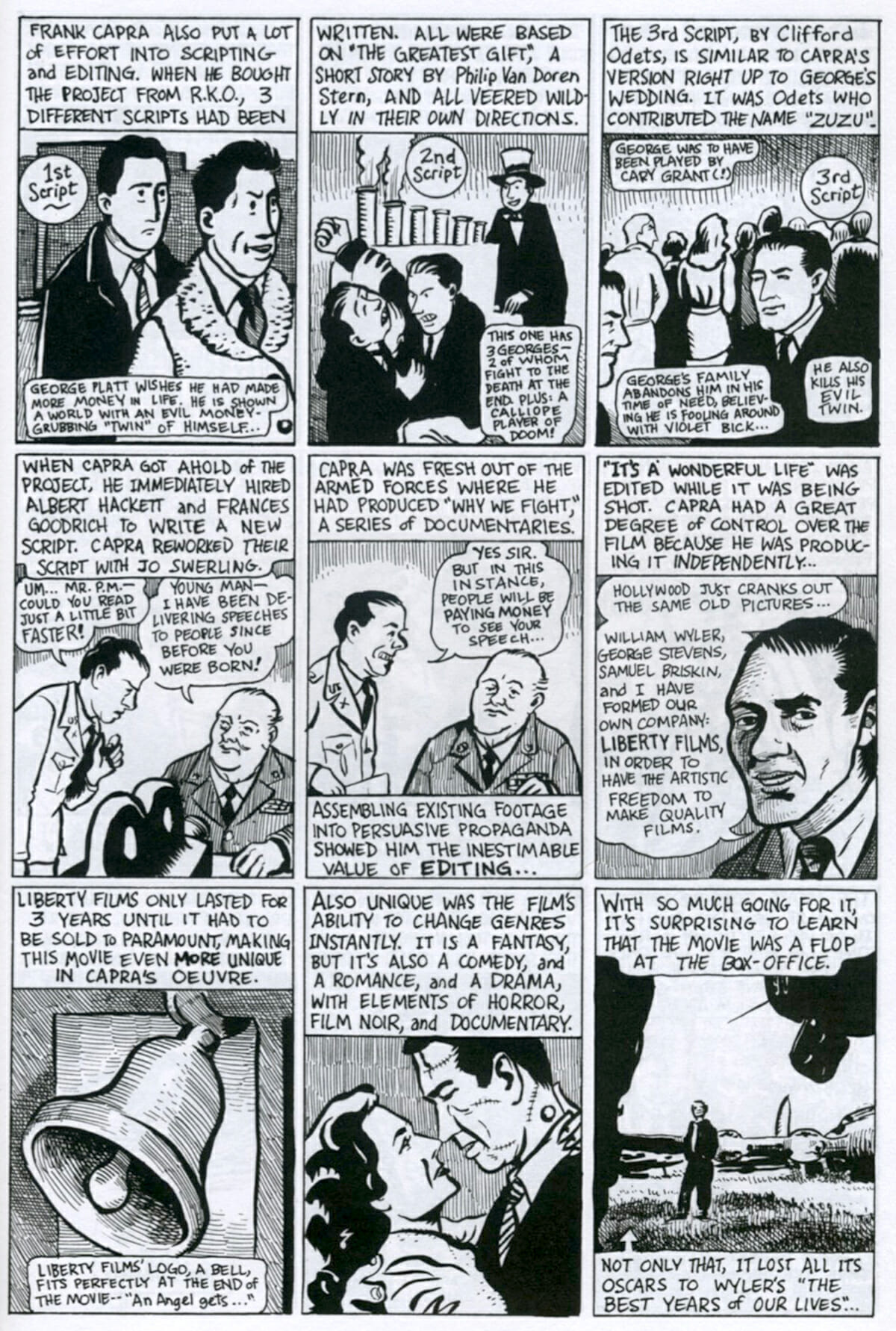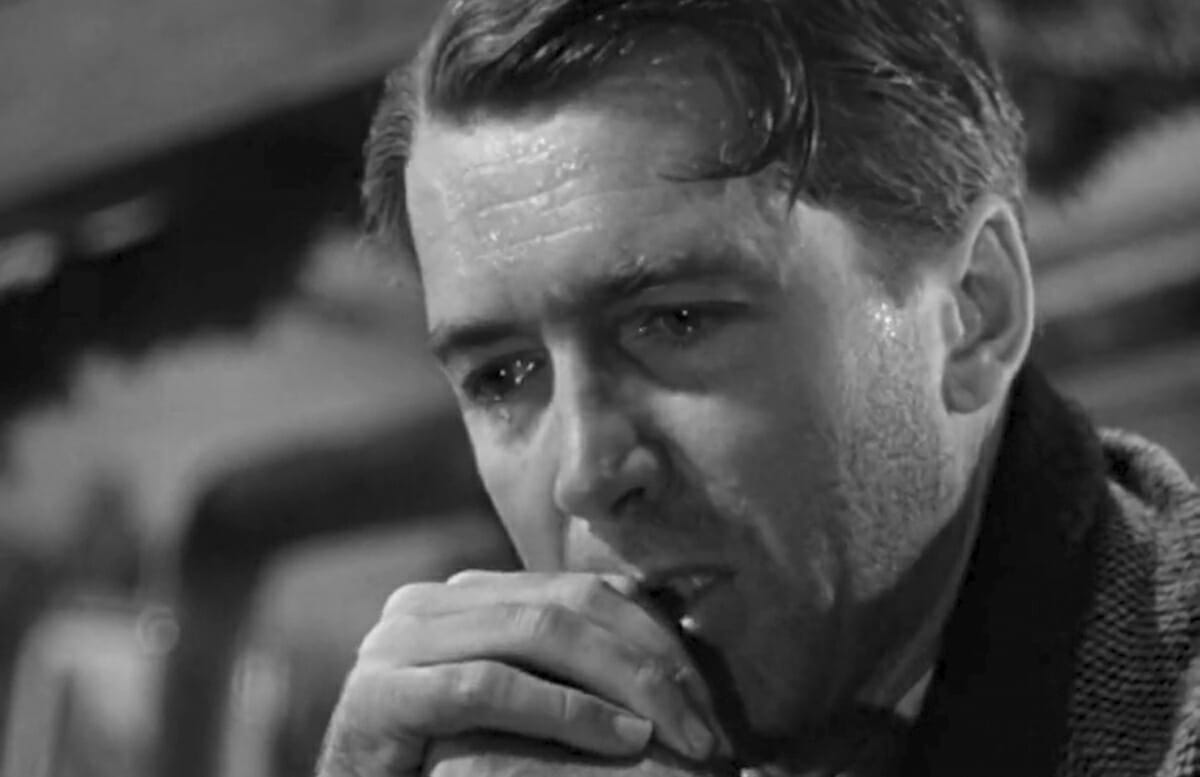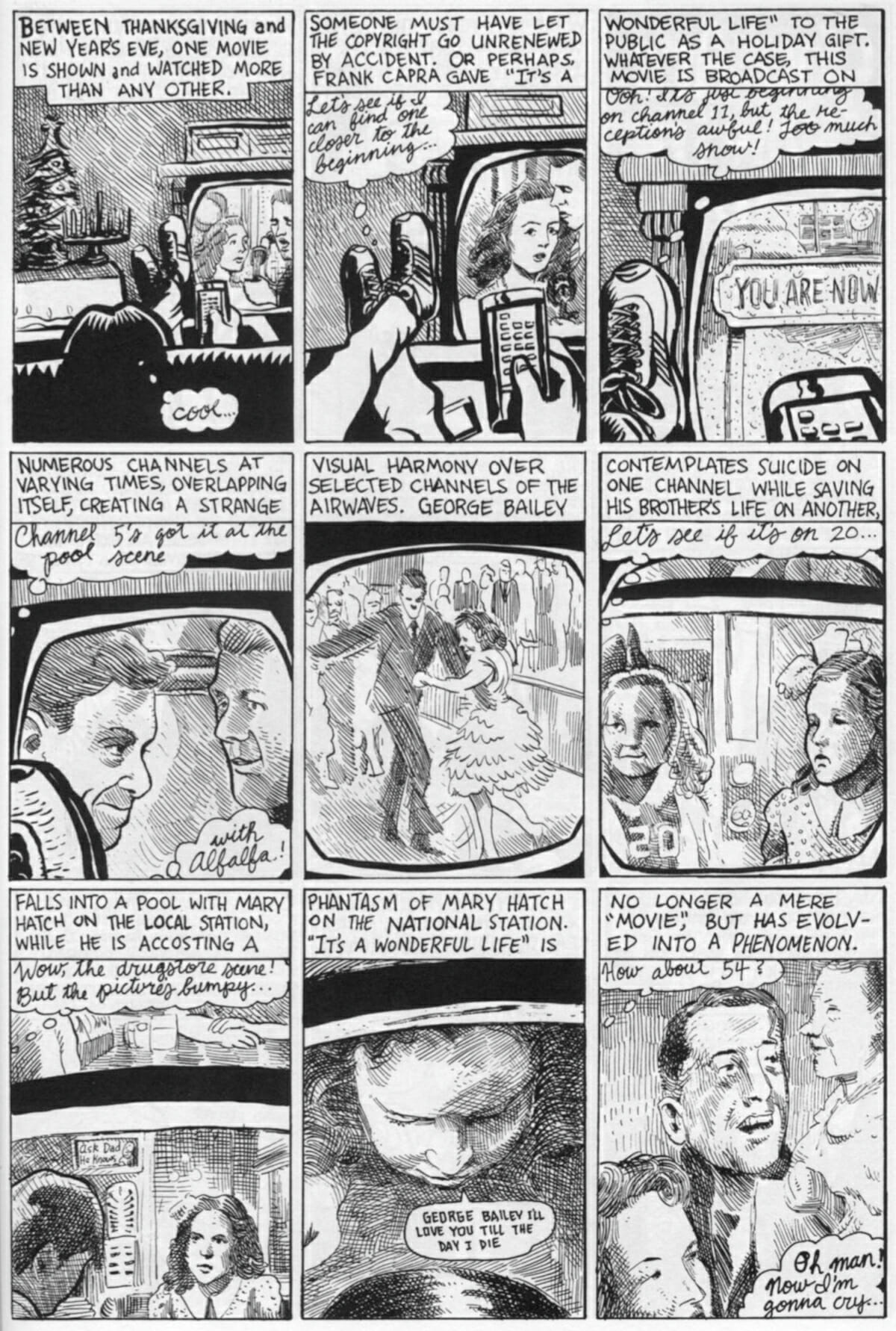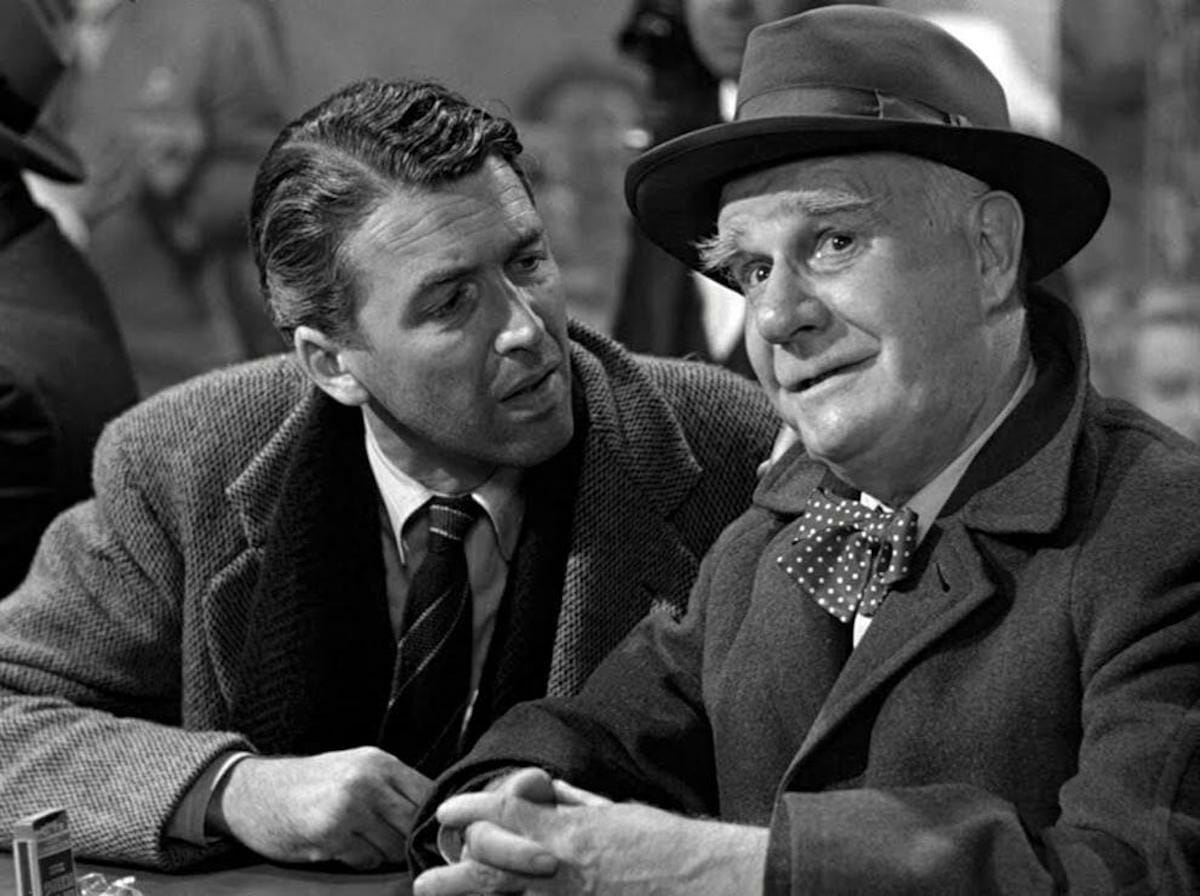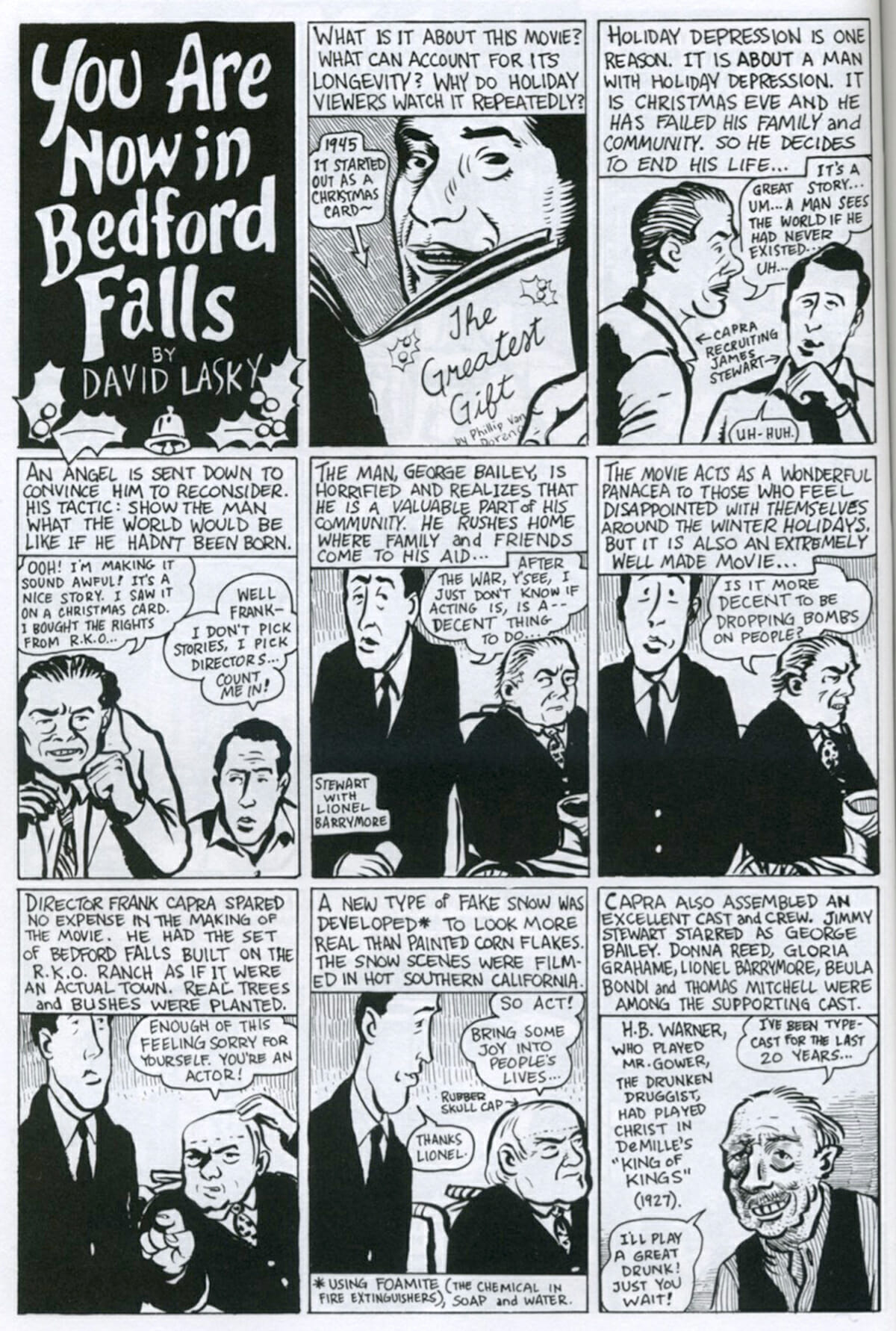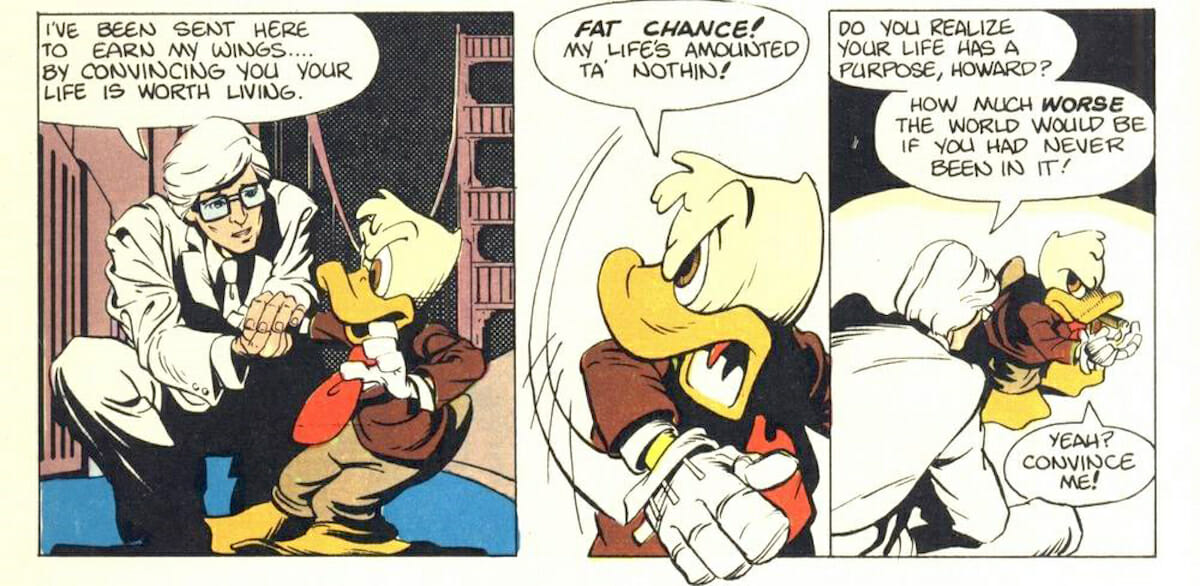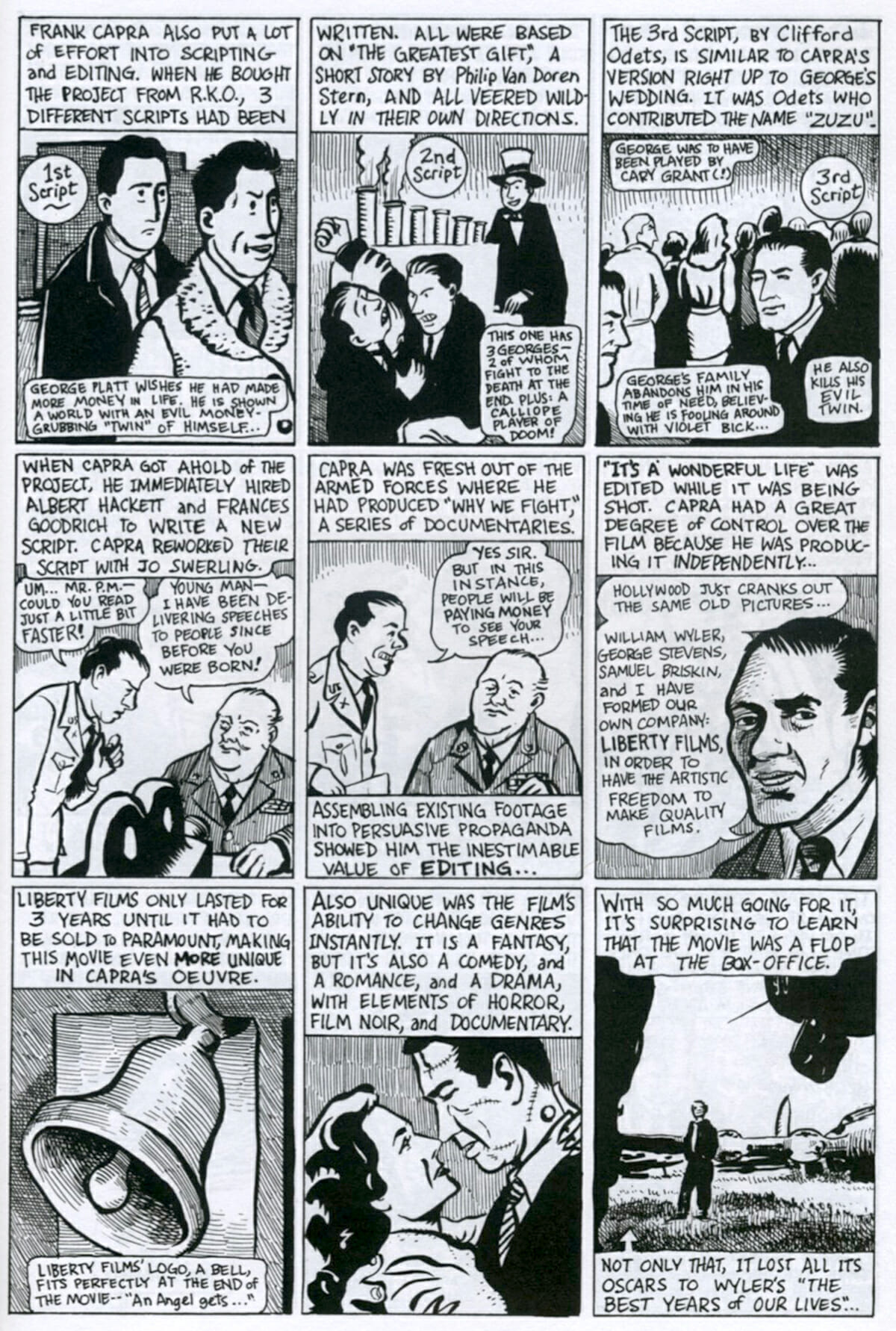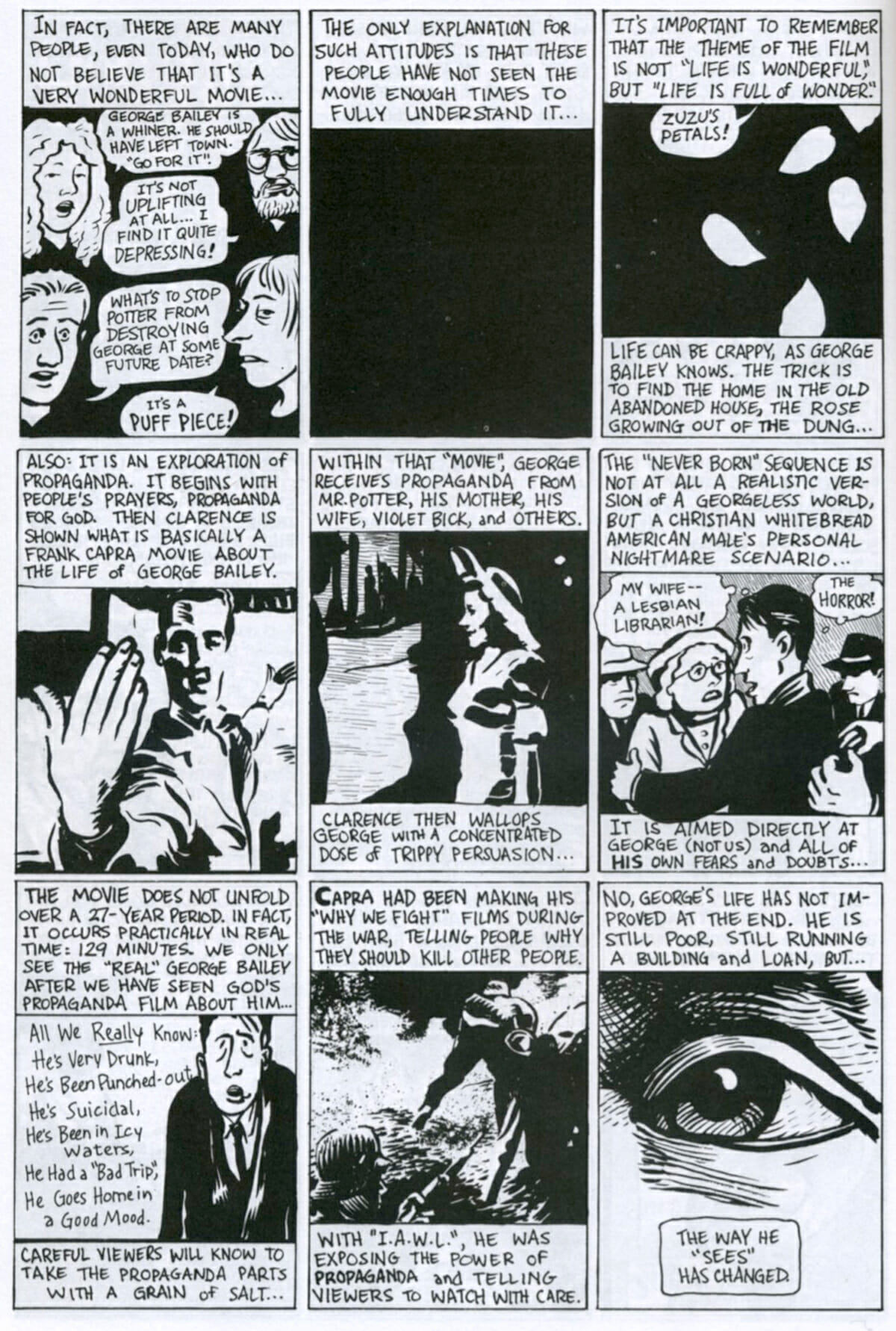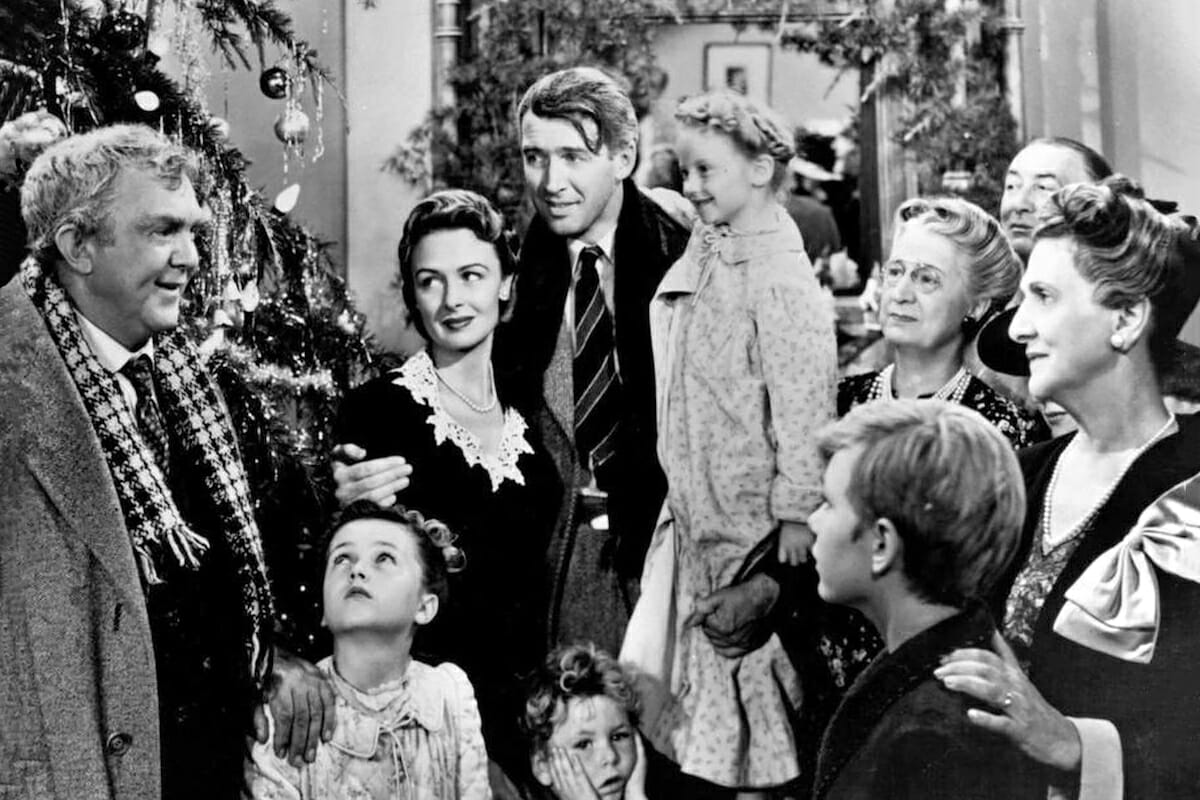In 1997, Eisner award-winning Seattle cartoonist David Lasky created a heartfelt and insightful comic strip exploring the pop-culture mythology of Frank Capra’s classic 1949 film, It’s a Wonderful Life. Lasky’s piece, You Are Now in Bedford Falls was published in Last Dangerous Christmas, a comic book anthology from Aeon Press. All proceeds from the collection were donated to organizations benefiting abused or neglected children. The anthology featured an abundance of talent including Kaja Foglio, Matt Howarth, Sarah Byam, and David Lee Ingersoll, all bound beneath cover art from the extraordinary Bill Sienkiewicz.
At the time of its publication Last Dangerous Christmas, not to mention Lasky’s contribution, fell under the radar of much of the comic book community. While Lasky’s more recent graphic novels like Oregon Trail: Road to Destiny and The Carter Family: Don’t Forget This Song remain at the forefront of many minds, his brief strip discussing the Capra film’s ability to delight our collective psyche deserves a return visit.
For the unindoctrinated, Frank Capra’s It’s a Wonderful Life is loosely based on Philip Van Doren Stern’s short story The Greatest Gift which, in turn, was loosely based on Charles Dickens’ A Christmas Carol. An RKO Radio Pictures Release, It’s a Wonderful Life tells the story of George Bailey (Jimmy Stewart), an American Everyman with a vivid interior life and grand dreams of traveling the globe in pursuit of a life of adventure. That life never happens. Instead, George puts aside his globetrotting aspirations in order to help run his family’s Building and Loan. George is a man who forever puts others ahead of himself—a self-sacrificing nature that ultimately makes him a beloved pillar of his community.
As time goes on George marries and raises a family while watching his dreams sail slowly into the sunset. When a financial tragedy blindsides George the resentment of so many dreams unfulfilled drives him straight to the bottom. Convincing himself he’s worth more dead than alive, George stands at an icy railing overlooking the black water below and contemplates ending his life. An apprentice angel named Clarence suddenly appears, tasked with convincing George his life is a great gift and what a great tragedy it would be for him to throw it all away.
Clarence hits upon the brilliant notion of showing George what the world would look like had he never been born. The alternate reality is a dark one without George and he quickly discovers he really had a wonderful life. Clarence’s plan succeeds and George’s Long Dark Night of the Soul changes his heart for the better. Upon returning to his familiar reality George finds the entire community of Bedford Falls has turned out to support him. The takeaway? No one is a failure who has friends.
Film scholars and fans agree the reason It’s a Wonderful Life became an institution was, in part, thanks to its failure at the box office. Following lackluster ticket sales and the demise of several studios handling the It’s a Wonderful Life film rights, ownership passed to National Telefilm Associates (NTA) where a clerical error kept the film’s copyright from being properly renewed in 1974. In short, It’s a Wonderful Life had never proven itself a money maker, so no one lobbied for ownership. By the late 1970s It’s a Wonderful Life became the darling of regional TV affiliates and Capra’s orphan went into annual holiday rotation up and down the dial. In some parts of the US, one could flip through channels and catch the film, albeit in varying qualities of print, at 10, 20 or 30-minute intervals. It was precisely this immersive experience that inscribed It’s a Wonderful Life upon the public consciousness, hence making it a holiday tradition and the regular viewing akin to ritual.
Lasky says he came to the film thanks to a comment from one of his comic book industry idols.
“I was a teenager in high school and would get kind of depressed in the winter months. I probably had SAD (Seasonal Affective Disorder) but didn’t realize it. Oddly enough, I had heard about It’s a Wonderful Life a few years earlier at a comic convention where the artist Paul Smith was describing a Howard the Duck story he’d drawn and was waiting to see published. He said it was based on It’s a Wonderful Life and I didn’t know what that was, so he gave me a bare bones description of the plot. It took a couple of years maybe until I caught it on television (like most everyone else). I think it was around that time that I was noticing Jimmy Stewart, in Hitchcock’s movies, and in Harvey, and already found him likable. So, I was on board right away with this movie. And like most people, I was quite moved by It’s a Wonderful Life. It seriously pulled me out of whatever winter depression I was in at the time.”
Film fans are deeply familiar with the soothing aspects of ritualistic, repeat viewings of beloved films like It’s a Wonderful Life. There is comfort in consistency, but unlike a film, the viewer’s perspective changes over time. Since penning You Are Now in Bedford Falls Lasky says time has revealed new things about the film, particularly in how it bumps up against contemporary pop-culture iconography. “So much of the movie is so weird, but in an everyday kind of way. Take the appearance of Carl ‘Alfalfa’ Switzer of The Little Rascals. You wonder: ‘Wait, is that ‘Alfalfa’?!’ The cop and the cab driver being named Ernie and Bert. The set design—as opposed to so many other movies— feels like a fully realized world that the characters have been living in for years. I think what you notice most are the differences between the life and the town you’ve been shown in flashback form vs. the ‘nightmare’ version that Clarence orders up for George. The film asks you to remember who everyone is and notice how they’ve changed in the transformed Bedford Falls.”
Lasky says he’s also become conscious of how the narrative of It’s a Wonderful Life has become mated to the television screen, thus making him reluctant to see it in the cinema. “I’m not sure I would like it as much. Part of the appeal, I think, of the small screen is the intimacy of it. It’s a quirky movie, with odd edits and low budget production quality. I almost worry that seeing it in a theater would just point out a lot of the clunky-ness of it. But I could be wrong. The fact that it only became a classic after it reached TV screens maybe speaks to the need to see it small.”
Indeed, Lasky believes time has conspired to confine our perception of It’s a Wonderful Life to the medium of television. “The movie kind of needed TV and needed to be seen on a small screen. And not just in that intimate size, but also in the casualness of TV. People were watching it at home and were perhaps suffering from winter or holiday-related depression. And in the privacy of your home, perhaps late at night, you could come across this odd movie that also feels darkness and despair at holiday time. I think that’s a secret strength of the movie when it’s on television. In a way, it says: ‘You’re not alone in feeling sad right now. Welcome to our secret club.’ But then it also flips that around and tells you: ‘The little things you’ve done in your life have had value, and made a difference for other people, even if you or they don’t realize it, etc.’ Some viewers, I know, don’t care for that easy answer to George’s depression. But I think it’s an important message. It reminds me of the quote by Gandhi (yes, Gandhi!): ‘Whatever you do in life will be insignificant, but it is very important that you do it because you can’t know. You can’t ever really know the meaning of your life.’”
In 1993 NTA’s successors Republic Pictures found a backdoor opportunity to retake ownership of It’s a Wonderful Life. Though the film’s original copyright had lapsed, ownership of the original short story on which the film was based had not. In 1994 the studio sold their exclusive television rights to It’s a Wonderful Life to NBC and the days of randomly encountering the Capra classic at all hours on numerous stations were over. All unauthorized screenings of the beloved film ceased. “It was no longer a weird old movie you’d stumble across on your local station and feel like you were discovering something that most people didn’t care about,” says Lasky. “Like you’d found a diamond in the rough. I guess I miss that feeling.”
Beloved as it was, for decades fans of It’s a Wonderful Life suffered through broadcasts of faded, murky, scratched or jumpy prints. One benefit of Republic regaining the film’s copyright meant the studio could return to the vault and offer up a crisp, clean print of the Capra director’s cut. Unfortunately, this restoration arrived in the era of digital colorization…but the less said about that the better. Regardless, how we watch It’s a Wonderful Life has been forever changed, but does the film’s cultural power still resonate?
“It’s a strange time in America right now,” says Lasky. “People might chip in a little or a lot to a call for help on social media, but at the same time witness people sleeping in bus shelters, tents, and doorways, in the cold, and kind of say to themselves: ‘That’s a bigger problem than I can deal with.’ We’re really lacking a collective ‘Save George Bailey’ action to get people housed. And create social programs that would help people get off of drugs, and treat mental illnesses, so people can stay off the streets. There is so much ridiculous wealth existing side-by-side with outrageous poverty here in Seattle. I think this holiday season, America, and the world, might benefit from multiple random broadcasts of It’s a Wonderful Life on their local TV stations, Netflix, YouTube and other streaming devices.”
It should come as no surprise the tale of George Bailey eventually breached the confines of the television screen and evolved into a grand, pop culture myth that stretches beyond Mr. Capra’s wildest dreams. In Lasky’s neck of the woods alone, the story of It’s a Wonderful Life has inspired artistic communities to seek ways to expand upon the film’s core meaning. In 2015 Seattle’s ArtsWest presented Helen Pafumi and Jason Lott’s Wonderful Life, a one-person performance wherein a young Black man (expertly portrayed by actor and playwright Andrew Lee Creech) stands atop a railway overpass contemplating suicide. Seeking an antidote for his despair, the young man reenacts the story of It’s a Wonderful Life from memory, playing various roles while walking himself back to a state of wholeness. And for over a decade the 14/48 Projects have presented Theater Anonymous: It’s a Wonderful Life.
Once a year, for a single performance, over 30 actors are cast in a production rehearsed entirely in secret save for the company of their co-directors. No one in the ensemble or the audience knows the casting until the artists appear on stage. Inspired by the community message of It’s a Wonderful Life, Theater Anonymous: It’s a Wonderful Life has shed the Capra film’s established cultural and gender roles by casting BIPOC, LGBTQ+ and Disabled artists.
It’s a Wonderful Life has pervaded our collective psyche and offered up a pop-culture myth that continues to evolve to better reflect how we wish to see ourselves. Fans of It’s a Wonderful Life seek to participate in the narrative beyond celluloid. Repeat viewings are but one way in which the viewer seeks to capture the joy of the experience and make it something less ephemeral, perhaps even tangible. David Lasky was present to this participation when he drew You Are Now in Bedford Falls 24 years ago. No one deserves to live in Pottersville. We are all worthy of a home in Bedford Falls.
A special thank you to David Lasky for granting us permission to reproduce *You Are Now in Bedford Falls . Learn more about Lasky’s current projects by visiting his Etsy page.*
